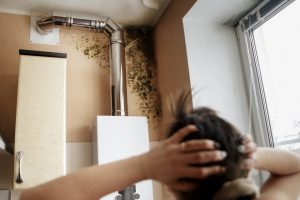What Is Included In A Mold Inspection? | Mold Testing NJ-NY

A common question is “What is included in a Mold Inspection?” For a structure, a property, or a home, a mold inspection is going to be unique so we thought we’d try and go over it here. Let’s look at what is involved in a typical ‘Mold Testing NJ-NY’ inspection.
We start out with a visual inspection of the structure starting systematically in the basement or crawlspace, then the 1st floor, 2nd floor, and attic. We look at all safely accessible areas, rooms/closets/windows/skylights for suspected mold, on visible framing, walls/ceilings, furniture, inside cabinets, behind baseboards, air vent registers, and inside the air handlers (AC unit, furnace), roofing decking/rafters.
We tell you what we see, what we think, the type of samples (air and/or physical) you may need, and why. We will also photograph the areas of concern included in the mold report. Mold sampling will determine if the mold levels of the areas sampled are elevated or within the acceptable ranges. Temperature and relative humidity are also recorded in these sampled areas. Based on the visual inspection and laboratory mold report it will be determined if mold remediation is required and/or just maintenance and cleaning is needed.
Water And Moisture In The Home
We are continually looking for water/moisture marks and suspect repainted/repaired areas. We scan the walls and ceilings with an InfraRed Thermal Imaging camera as a guide for suspected water or moisture and then utilize two different moisture meters for areas of suspected moisture or water at the time of the inspection.
Areas may have water or moisture marks but not be elevated or wet at the time of the inspection (e.g. past leak). These areas are prone to mold and sampling is recommended.
The Importance Of Air Samples
Why take physical and/or air mold samples? We use them to determine the type of mold growing on a surface and airborne (e.g. what you breathe in). Some people have different sensitivity to some molds, these results are also used for real estate transactions, information for the attorneys, and insurance companies to document the mold levels in houses.
Even if you do not suspect elevated mold levels in the house, air sampling will determine the baseline mold levels in the air. If mold remediation is needed, you will have a reference for where the mold levels start. Then also for after mold remediation occurs, if the remediator has removed the physical mold and lowered the air borne molds to within acceptable ranges. All houses have mold levels in the air, it is just what kind and how much that will be documented.
Types Of Mold Sampling Include:
- Air Samples
- Swab Samples
- Tape Lift Samples
- Bulk Physical Samples
- Other types of mold sampling are available. ERMI Testing, MVOC (mold volatile organic compound air sampling)
All suspected mold samples taken are sent to a certified laboratory for analysis and verification of mold. A Certificate of Mold Analysis is issued. This report will tell us what kind and the air samples will tell us what kind of mold is airborne and approximately how many spores per cubic meter were found at the time of the inspection. Some levels of airborne molds may not be elevated but are still an irritant to certain individuals. Further evaluation by a physician/allergist may be needed to determine if the mold found in the laboratory report is an irritant. People’s sensitivity to mold is different and so what bothers some people may not bother others.
Offering Certified NJ Mold Inspections In:
We are Bergen County, NJ-based, but as ‘mold inspector’ we also serve Union County, Passaic County, Hudson County, Essex County, Morris County, and Sussex County, NJ as well as Rockland County, NY, Orange County, and Westchester County, NY!
Useful Information, Questions, Answers About Mold And Mold Inspections

